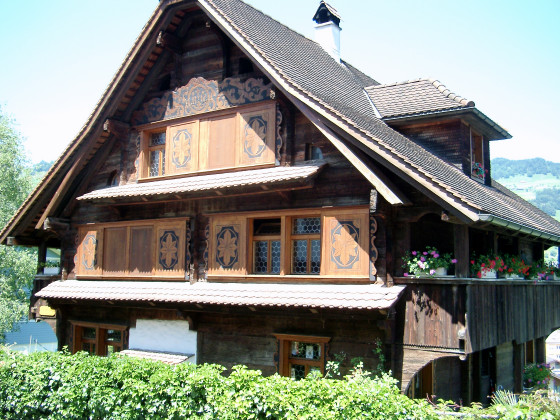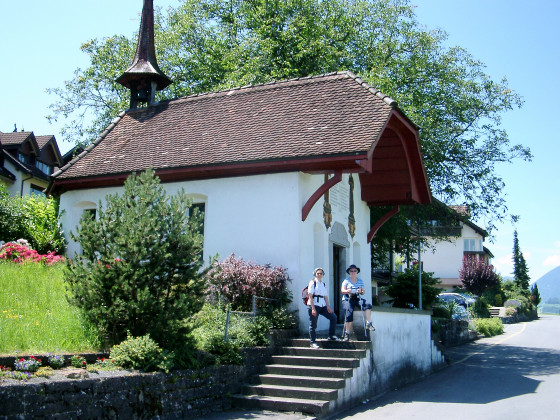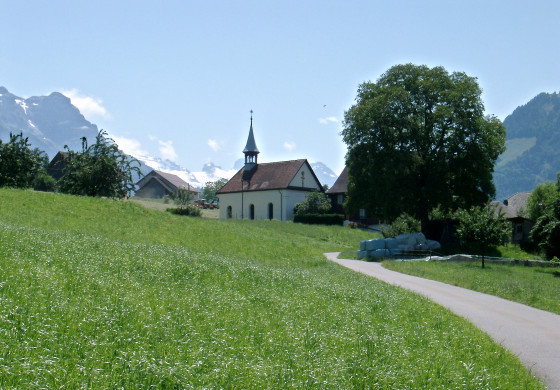Way of St James from Beckenried to Stans
On the road with Andrea and Vreni. We visited all the chapels - and there are quite a lot!

At the beginning of our pilgrimage stage we visited the church in Beckenried. At the entrance you can see a gravestone which testifies to a pilgrim from 1640, the ensign Jakob Stalder. The shell identifies him as a pilgrim to St. James.

Inscription on pilgrim gravestone
DER EDEL VEST WEIS
VND FROM HER LAND
TSFENDERICH IACOB
STALDER RIDTER DES
HEILIGEN GRABS VND
BILGER SANT IACOBS
ZV COMPOSTEL STARB
DEN 6 DAG MERTZEN
DES 1640 JARS
The noble very wise
and pious Landesfähnrich
Jacob Stalder
Knight of the holy grave
and pilgrim Saint James
at Compostelle died
on 6th of march
of the year 1640
The picture shows the Jerusalem Cross on the left and the Order of Saint Catherine on the right. This means that Knight Stalder was visiting the monastery of St. Catherine in Bethlehem.


Shortly after Beckenried we come across the pilgrimage church Maria im Ridli. On the back wall there are many votive pictures.

On the outskirts of Buochs we found this chapel of the 14 holy helpers.

The back wall inside the chapel shows the 14 holy helpers.
Dionysius is depicted very drastically. He was bishop of Paris (then Lutetia) around 250, which displeased the Roman governor. He ordered the arrest and beheading of Dionysius. Legend has it that Dionysius took up his severed head in the Montmartre square, washed it in a nearby spring and, with his head in his hands, walked six kilometres north to the place where he wanted to be buried.
He helps against headaches!

The Martins Church of Buochs

Inside the baroque church of St. Martin there is a Gothic statue of Anna-Selbdritt (Virgin and Child with Saint Anne) St. Anne is particularly venerated in this area. The name Anna is also quite common among the population.
Inscription beside the statue:
St. Anna - Selbtritt around 1500
Was brought to Lucerne during the Zurich Reformation. After 1798 it was donated to the burnt-out church of Buochs.

In Buochs we pass this beautiful farmhouse.

Next stop is the Buochs Obergasskapelle "Sieben Schmerzen Mariä" (Obergass chapel Seven Pains of Mary), a rural baroque building from 1662.

The path leads slightly uphill to the Waltersberg.

The St. Anna Chapel on the Waltersberg

On the Way of St James from Waltersberg to Stans

View from Waltersberg to Stans

At the entrance to Stans, to the right below the path at about 100 metres, we see an interesting house with unusual loggias, which does not really fit into the area. It is the Winkelriedhaus. It belonged to the Winkelried family in the late Middle Ages.
In 1560, it was acquired by the Landammann ( country representative ) knight Melchior Lussy ...

... and he converted the Winkelriedhaus into a stately residence in the style of the Italian Renaissance.
Today the house belongs to the canton and is used for exhibitions.

We pass the Capuchin monastery. It was founded in 1582-84 by Melchior Lussy. The present church was built in the 17th century by the grandson Ludwig Lussy (also a landammann and saint's grave knight). In 1907 and 1924, the monastery complex was rebuilt and extended.

This is what it looks like in the Capuchin Church:

The stage finish Stans has been reached.

Stans from above.
This picture was taken during a hike on the Buochser Horn in autumn 2007. On the left the slope of the Stanser Horn, on the right the Bürgenstock, in the centre of the picture Stans and behind it branches of Lake Lucerne. In the background Pilatus, covered with clouds.
How about a trip to the Stanserhorn?


